Health Informatics: EHR System Analysis for Patient Outcomes
VerifiedAdded on 2022/08/12
|6
|1170
|32
Report
AI Summary
This report analyzes the implementation of an Electronic Health Record (EHR) system within a hospital setting, focusing on improving patient outcomes, particularly in the area of obesity management. It evaluates the EHR system's capabilities, including the incorporation of evidence-based practices, the use of clinical alerts, and the integration of patient data. The report explores key data elements essential for the EHR system, such as patient identification, risk factors, vital signs, and medication information. It discusses strategies to promote well-informed diagnoses, support optimal treatment planning, and ensure continuity of care. Furthermore, the report examines how EHR systems can be designed to enhance patient-related outcomes through reminders, clinical alerts, and improved communication. The conclusion emphasizes the importance of strategic planning and addressing barriers to successful EHR implementation for improved healthcare quality and patient care.

Running head: HEALTH INFORMATICS
Health Informatics
Name of the Student
Name of the University
Author’s Note
Health Informatics
Name of the Student
Name of the University
Author’s Note
Paraphrase This Document
Need a fresh take? Get an instant paraphrase of this document with our AI Paraphraser
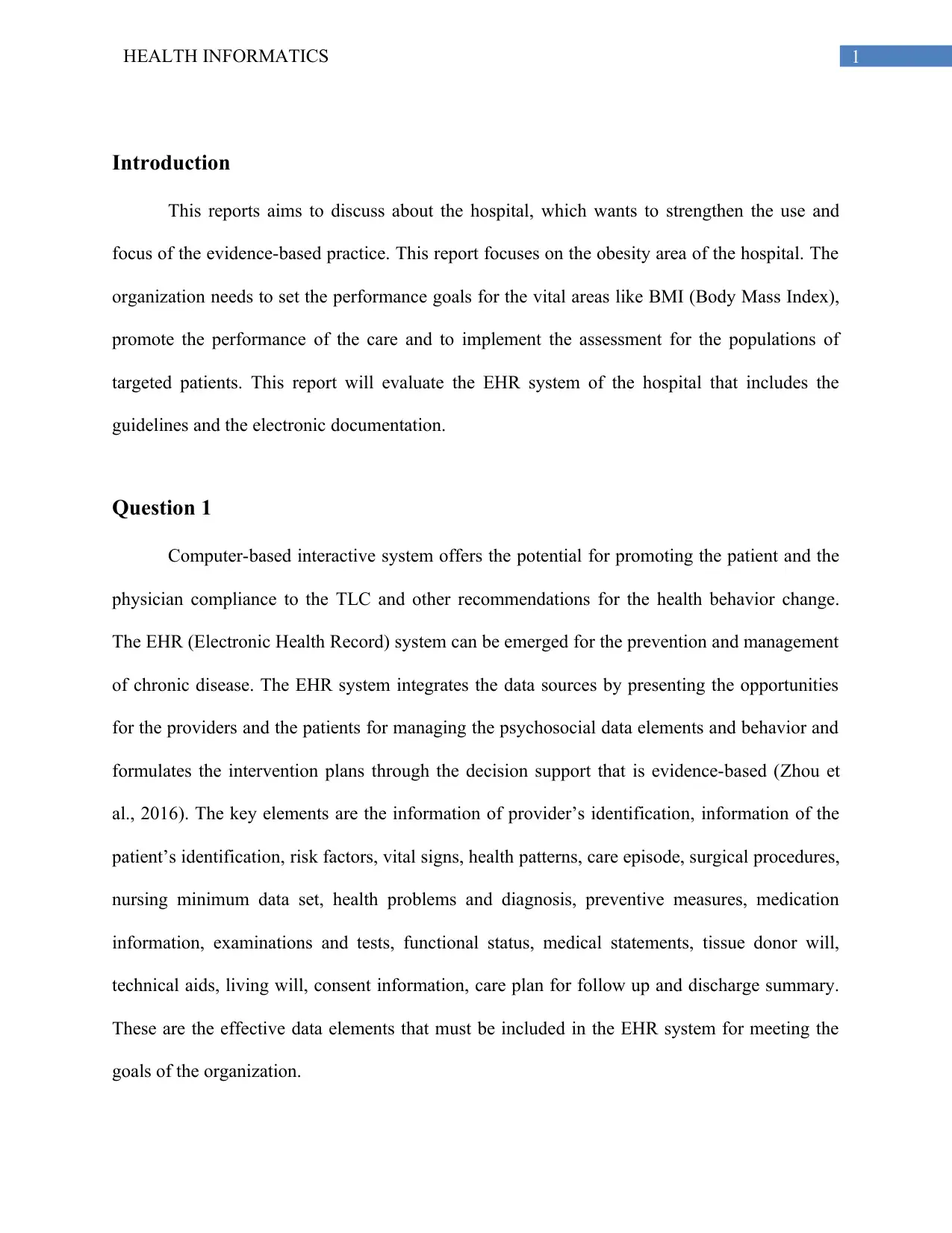
1HEALTH INFORMATICS
Introduction
This reports aims to discuss about the hospital, which wants to strengthen the use and
focus of the evidence-based practice. This report focuses on the obesity area of the hospital. The
organization needs to set the performance goals for the vital areas like BMI (Body Mass Index),
promote the performance of the care and to implement the assessment for the populations of
targeted patients. This report will evaluate the EHR system of the hospital that includes the
guidelines and the electronic documentation.
Question 1
Computer-based interactive system offers the potential for promoting the patient and the
physician compliance to the TLC and other recommendations for the health behavior change.
The EHR (Electronic Health Record) system can be emerged for the prevention and management
of chronic disease. The EHR system integrates the data sources by presenting the opportunities
for the providers and the patients for managing the psychosocial data elements and behavior and
formulates the intervention plans through the decision support that is evidence-based (Zhou et
al., 2016). The key elements are the information of provider’s identification, information of the
patient’s identification, risk factors, vital signs, health patterns, care episode, surgical procedures,
nursing minimum data set, health problems and diagnosis, preventive measures, medication
information, examinations and tests, functional status, medical statements, tissue donor will,
technical aids, living will, consent information, care plan for follow up and discharge summary.
These are the effective data elements that must be included in the EHR system for meeting the
goals of the organization.
Introduction
This reports aims to discuss about the hospital, which wants to strengthen the use and
focus of the evidence-based practice. This report focuses on the obesity area of the hospital. The
organization needs to set the performance goals for the vital areas like BMI (Body Mass Index),
promote the performance of the care and to implement the assessment for the populations of
targeted patients. This report will evaluate the EHR system of the hospital that includes the
guidelines and the electronic documentation.
Question 1
Computer-based interactive system offers the potential for promoting the patient and the
physician compliance to the TLC and other recommendations for the health behavior change.
The EHR (Electronic Health Record) system can be emerged for the prevention and management
of chronic disease. The EHR system integrates the data sources by presenting the opportunities
for the providers and the patients for managing the psychosocial data elements and behavior and
formulates the intervention plans through the decision support that is evidence-based (Zhou et
al., 2016). The key elements are the information of provider’s identification, information of the
patient’s identification, risk factors, vital signs, health patterns, care episode, surgical procedures,
nursing minimum data set, health problems and diagnosis, preventive measures, medication
information, examinations and tests, functional status, medical statements, tissue donor will,
technical aids, living will, consent information, care plan for follow up and discharge summary.
These are the effective data elements that must be included in the EHR system for meeting the
goals of the organization.
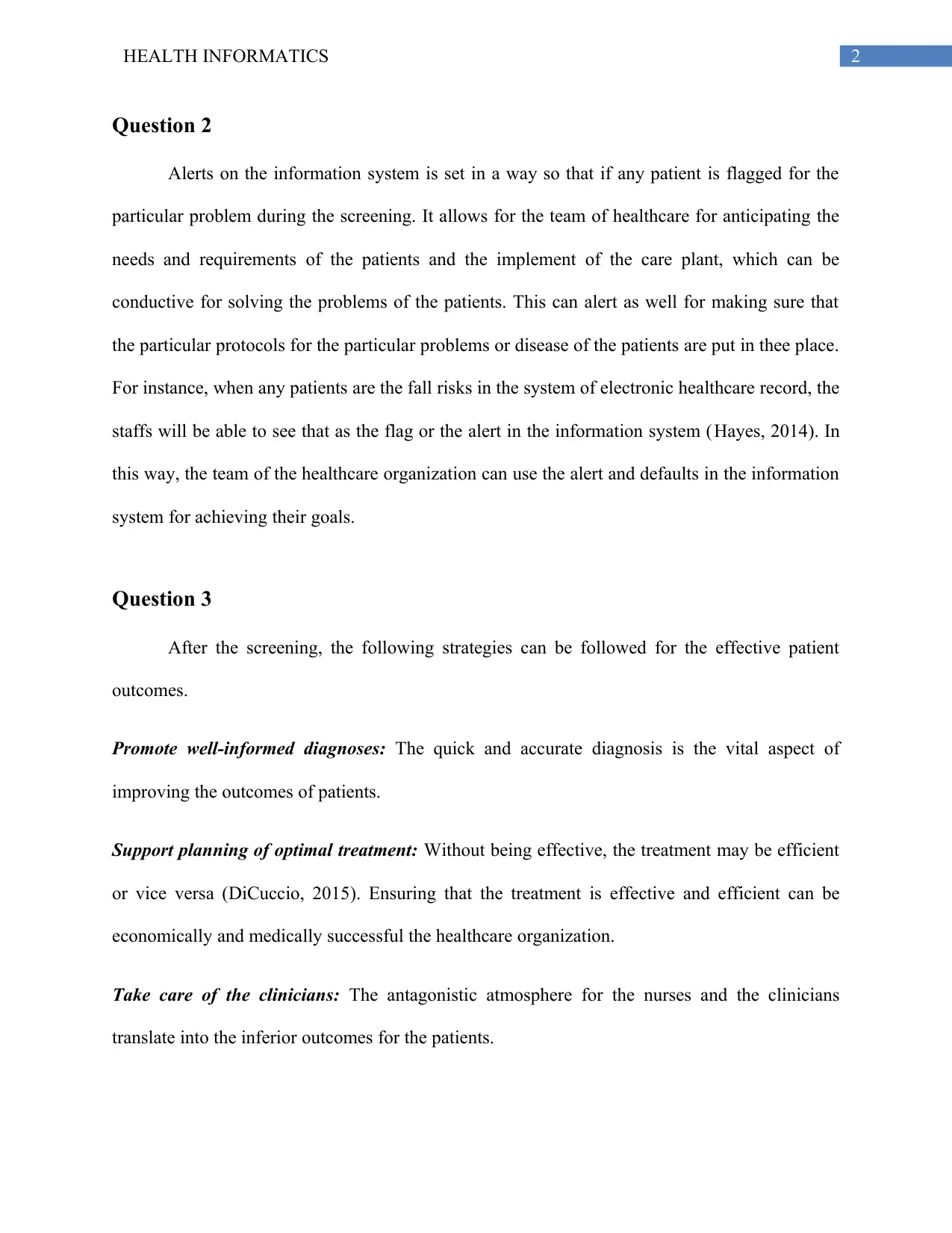
2HEALTH INFORMATICS
Question 2
Alerts on the information system is set in a way so that if any patient is flagged for the
particular problem during the screening. It allows for the team of healthcare for anticipating the
needs and requirements of the patients and the implement of the care plant, which can be
conductive for solving the problems of the patients. This can alert as well for making sure that
the particular protocols for the particular problems or disease of the patients are put in thee place.
For instance, when any patients are the fall risks in the system of electronic healthcare record, the
staffs will be able to see that as the flag or the alert in the information system (Hayes, 2014). In
this way, the team of the healthcare organization can use the alert and defaults in the information
system for achieving their goals.
Question 3
After the screening, the following strategies can be followed for the effective patient
outcomes.
Promote well-informed diagnoses: The quick and accurate diagnosis is the vital aspect of
improving the outcomes of patients.
Support planning of optimal treatment: Without being effective, the treatment may be efficient
or vice versa (DiCuccio, 2015). Ensuring that the treatment is effective and efficient can be
economically and medically successful the healthcare organization.
Take care of the clinicians: The antagonistic atmosphere for the nurses and the clinicians
translate into the inferior outcomes for the patients.
Question 2
Alerts on the information system is set in a way so that if any patient is flagged for the
particular problem during the screening. It allows for the team of healthcare for anticipating the
needs and requirements of the patients and the implement of the care plant, which can be
conductive for solving the problems of the patients. This can alert as well for making sure that
the particular protocols for the particular problems or disease of the patients are put in thee place.
For instance, when any patients are the fall risks in the system of electronic healthcare record, the
staffs will be able to see that as the flag or the alert in the information system (Hayes, 2014). In
this way, the team of the healthcare organization can use the alert and defaults in the information
system for achieving their goals.
Question 3
After the screening, the following strategies can be followed for the effective patient
outcomes.
Promote well-informed diagnoses: The quick and accurate diagnosis is the vital aspect of
improving the outcomes of patients.
Support planning of optimal treatment: Without being effective, the treatment may be efficient
or vice versa (DiCuccio, 2015). Ensuring that the treatment is effective and efficient can be
economically and medically successful the healthcare organization.
Take care of the clinicians: The antagonistic atmosphere for the nurses and the clinicians
translate into the inferior outcomes for the patients.
⊘ This is a preview!⊘
Do you want full access?
Subscribe today to unlock all pages.

Trusted by 1+ million students worldwide
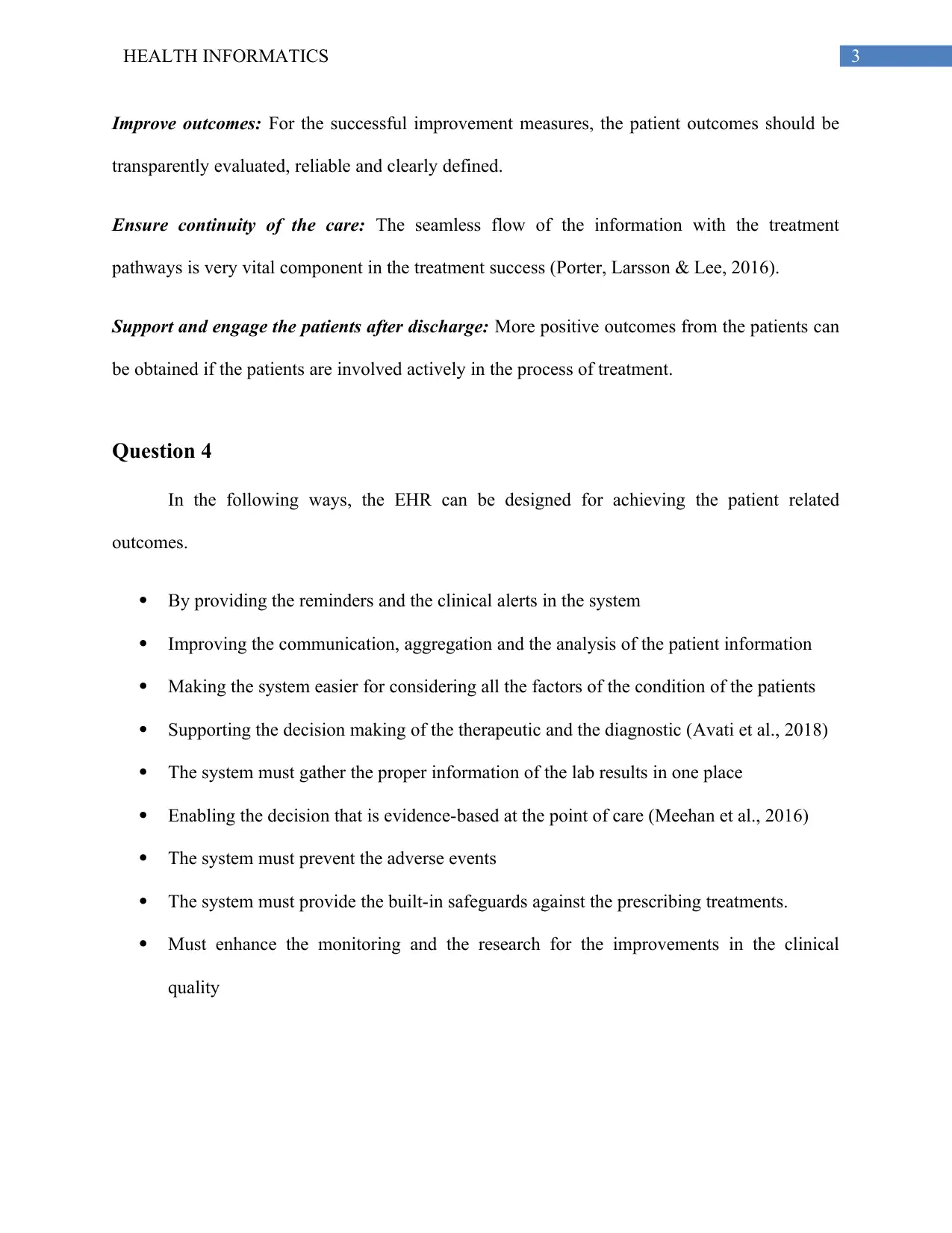
3HEALTH INFORMATICS
Improve outcomes: For the successful improvement measures, the patient outcomes should be
transparently evaluated, reliable and clearly defined.
Ensure continuity of the care: The seamless flow of the information with the treatment
pathways is very vital component in the treatment success (Porter, Larsson & Lee, 2016).
Support and engage the patients after discharge: More positive outcomes from the patients can
be obtained if the patients are involved actively in the process of treatment.
Question 4
In the following ways, the EHR can be designed for achieving the patient related
outcomes.
By providing the reminders and the clinical alerts in the system
Improving the communication, aggregation and the analysis of the patient information
Making the system easier for considering all the factors of the condition of the patients
Supporting the decision making of the therapeutic and the diagnostic (Avati et al., 2018)
The system must gather the proper information of the lab results in one place
Enabling the decision that is evidence-based at the point of care (Meehan et al., 2016)
The system must prevent the adverse events
The system must provide the built-in safeguards against the prescribing treatments.
Must enhance the monitoring and the research for the improvements in the clinical
quality
Improve outcomes: For the successful improvement measures, the patient outcomes should be
transparently evaluated, reliable and clearly defined.
Ensure continuity of the care: The seamless flow of the information with the treatment
pathways is very vital component in the treatment success (Porter, Larsson & Lee, 2016).
Support and engage the patients after discharge: More positive outcomes from the patients can
be obtained if the patients are involved actively in the process of treatment.
Question 4
In the following ways, the EHR can be designed for achieving the patient related
outcomes.
By providing the reminders and the clinical alerts in the system
Improving the communication, aggregation and the analysis of the patient information
Making the system easier for considering all the factors of the condition of the patients
Supporting the decision making of the therapeutic and the diagnostic (Avati et al., 2018)
The system must gather the proper information of the lab results in one place
Enabling the decision that is evidence-based at the point of care (Meehan et al., 2016)
The system must prevent the adverse events
The system must provide the built-in safeguards against the prescribing treatments.
Must enhance the monitoring and the research for the improvements in the clinical
quality
Paraphrase This Document
Need a fresh take? Get an instant paraphrase of this document with our AI Paraphraser
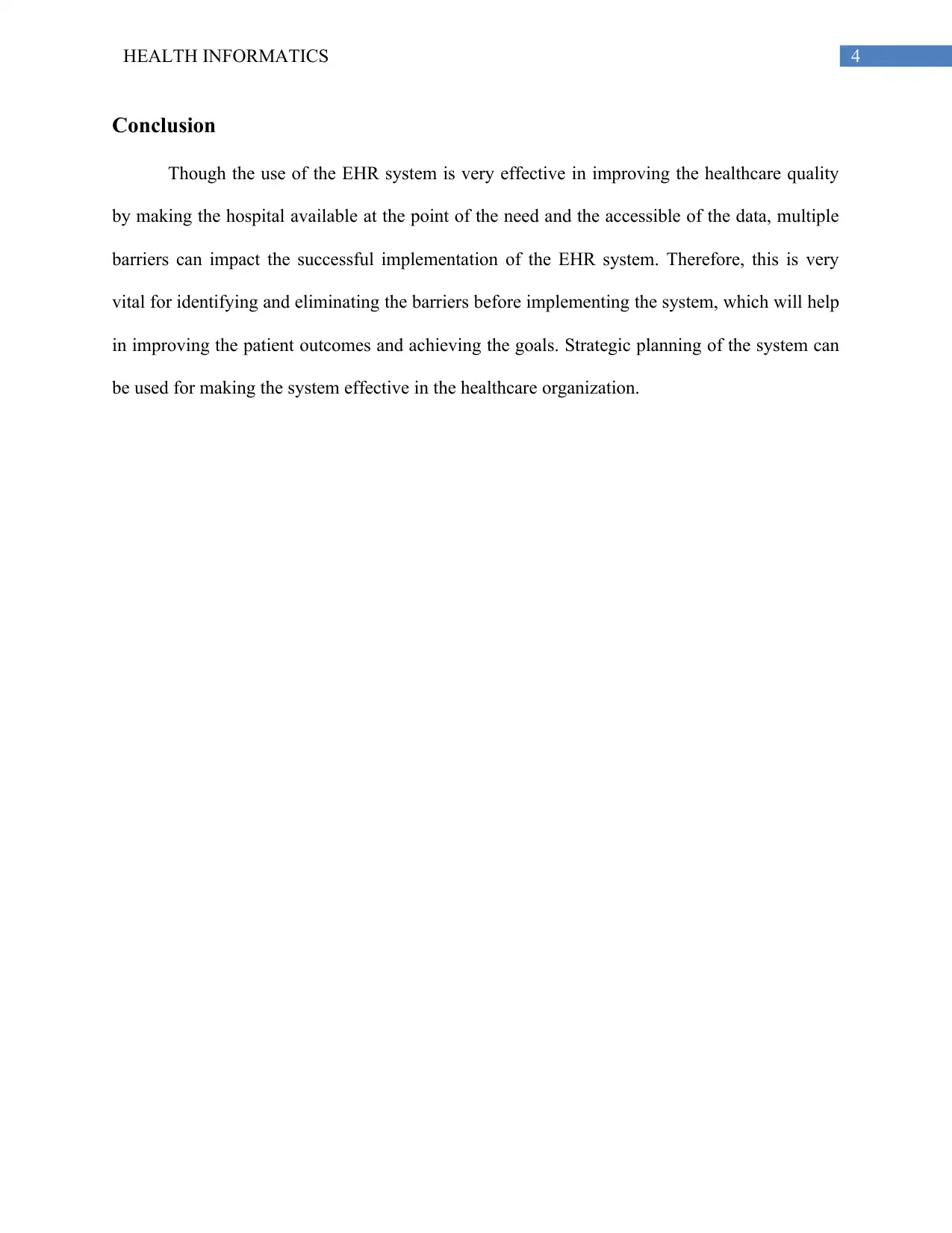
4HEALTH INFORMATICS
Conclusion
Though the use of the EHR system is very effective in improving the healthcare quality
by making the hospital available at the point of the need and the accessible of the data, multiple
barriers can impact the successful implementation of the EHR system. Therefore, this is very
vital for identifying and eliminating the barriers before implementing the system, which will help
in improving the patient outcomes and achieving the goals. Strategic planning of the system can
be used for making the system effective in the healthcare organization.
Conclusion
Though the use of the EHR system is very effective in improving the healthcare quality
by making the hospital available at the point of the need and the accessible of the data, multiple
barriers can impact the successful implementation of the EHR system. Therefore, this is very
vital for identifying and eliminating the barriers before implementing the system, which will help
in improving the patient outcomes and achieving the goals. Strategic planning of the system can
be used for making the system effective in the healthcare organization.
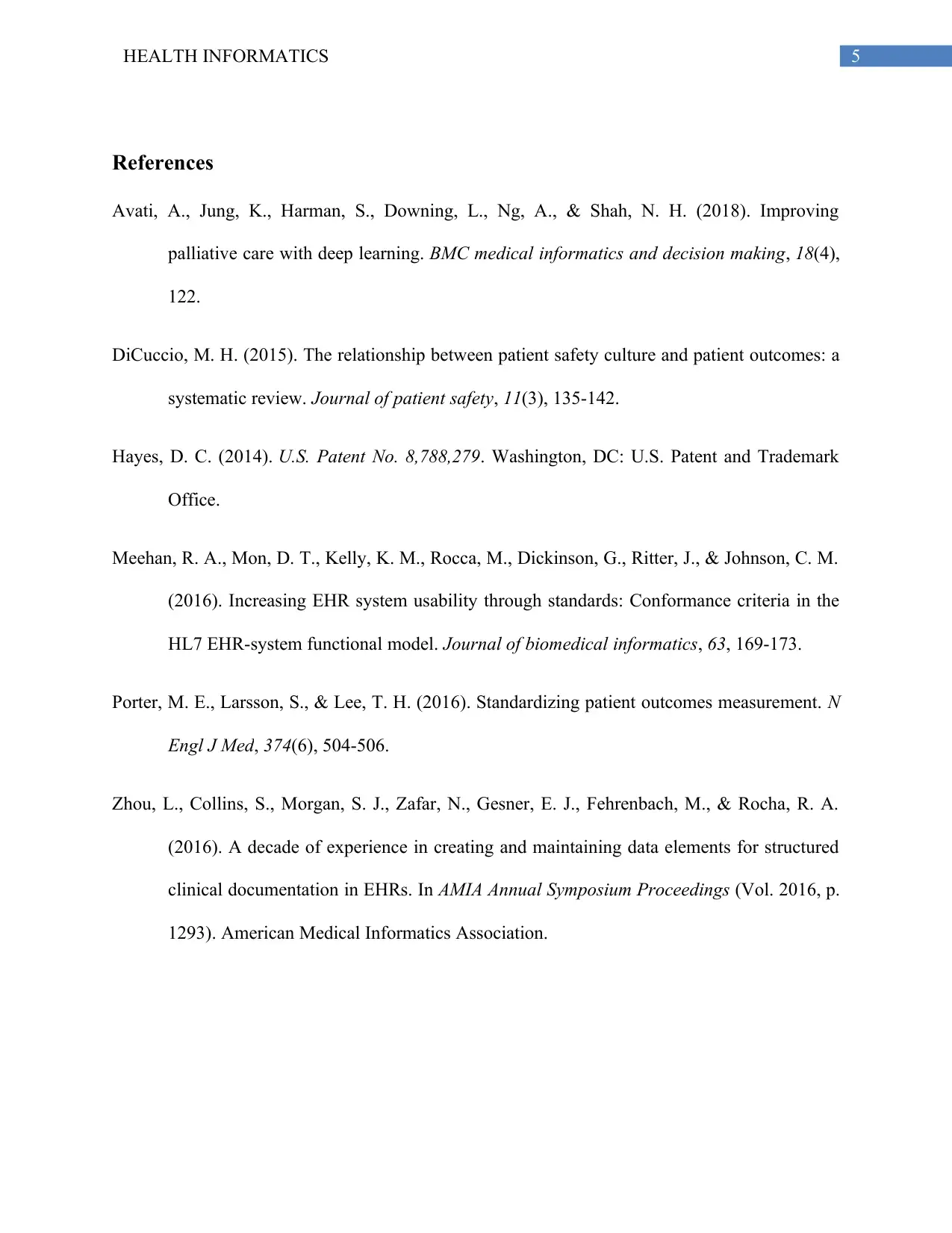
5HEALTH INFORMATICS
References
Avati, A., Jung, K., Harman, S., Downing, L., Ng, A., & Shah, N. H. (2018). Improving
palliative care with deep learning. BMC medical informatics and decision making, 18(4),
122.
DiCuccio, M. H. (2015). The relationship between patient safety culture and patient outcomes: a
systematic review. Journal of patient safety, 11(3), 135-142.
Hayes, D. C. (2014). U.S. Patent No. 8,788,279. Washington, DC: U.S. Patent and Trademark
Office.
Meehan, R. A., Mon, D. T., Kelly, K. M., Rocca, M., Dickinson, G., Ritter, J., & Johnson, C. M.
(2016). Increasing EHR system usability through standards: Conformance criteria in the
HL7 EHR-system functional model. Journal of biomedical informatics, 63, 169-173.
Porter, M. E., Larsson, S., & Lee, T. H. (2016). Standardizing patient outcomes measurement. N
Engl J Med, 374(6), 504-506.
Zhou, L., Collins, S., Morgan, S. J., Zafar, N., Gesner, E. J., Fehrenbach, M., & Rocha, R. A.
(2016). A decade of experience in creating and maintaining data elements for structured
clinical documentation in EHRs. In AMIA Annual Symposium Proceedings (Vol. 2016, p.
1293). American Medical Informatics Association.
References
Avati, A., Jung, K., Harman, S., Downing, L., Ng, A., & Shah, N. H. (2018). Improving
palliative care with deep learning. BMC medical informatics and decision making, 18(4),
122.
DiCuccio, M. H. (2015). The relationship between patient safety culture and patient outcomes: a
systematic review. Journal of patient safety, 11(3), 135-142.
Hayes, D. C. (2014). U.S. Patent No. 8,788,279. Washington, DC: U.S. Patent and Trademark
Office.
Meehan, R. A., Mon, D. T., Kelly, K. M., Rocca, M., Dickinson, G., Ritter, J., & Johnson, C. M.
(2016). Increasing EHR system usability through standards: Conformance criteria in the
HL7 EHR-system functional model. Journal of biomedical informatics, 63, 169-173.
Porter, M. E., Larsson, S., & Lee, T. H. (2016). Standardizing patient outcomes measurement. N
Engl J Med, 374(6), 504-506.
Zhou, L., Collins, S., Morgan, S. J., Zafar, N., Gesner, E. J., Fehrenbach, M., & Rocha, R. A.
(2016). A decade of experience in creating and maintaining data elements for structured
clinical documentation in EHRs. In AMIA Annual Symposium Proceedings (Vol. 2016, p.
1293). American Medical Informatics Association.
⊘ This is a preview!⊘
Do you want full access?
Subscribe today to unlock all pages.

Trusted by 1+ million students worldwide
1 out of 6
Related Documents
Your All-in-One AI-Powered Toolkit for Academic Success.
+13062052269
info@desklib.com
Available 24*7 on WhatsApp / Email
![[object Object]](/_next/static/media/star-bottom.7253800d.svg)
Unlock your academic potential
Copyright © 2020–2025 A2Z Services. All Rights Reserved. Developed and managed by ZUCOL.





